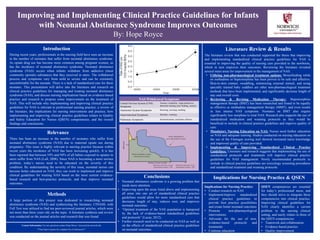
NAS POSTER FINAL V
- 1. Improving and Implementing Clinical Practice Guidelines for Infants with Neonatal Abstinence Syndrome Improves Outcomes By: Hope Royce Introduction During recent years, professionals in the nursing field have seen an increase in the number of neonates that suffer from neonatal abstinence syndrome. As opiate drug use has become more common among pregnant women, so has the incidence of neonatal abstinence syndrome. Neonatal abstinence syndrome (NAS) occurs when infants withdraw from addictive (most commonly opioids) substances that they received in utero. The withdrawal process and symptoms vary from mild to severe and can be extremely uncomfortable for the neonate. There is a lack of standardized care for these neonates. This presentation will delve into the literature and research on clinical practice guidelines for managing and treating neonatal abstinence syndrome (NAS), and discuss nursing implications based on evidence-based practice and research to propose some improvement on the treatment of NAS. This will include why implementing and improving clinical practice guidelines for NAS is relevant to professional nursing practice, a review of the literature, the implications for nursing interventions and practice, how implementing and improving clinical practice guidelines relates to Quality and Safety Education for Nurses (QSEN) competencies, and the overall findings and conclusions. Relevance There has been an increase in the number of neonates who suffer from neonatal abstinence syndrome (NAS) due to maternal opiate use during pregnancy. This issue is highly relevant to nursing practice because within recent years the incidence of NAS has been increasing quickly. It is has been reported that between 54% and 94% of all babies exposed to opiates in utero suffer from NAS (Lall, 2008). Since NAS is becoming a more serious problem, today’s nurses need to be educated on the severity of this condition. By understanding the severity of this issue, neonatal nurses can become better educated on NAS; they can work to implement and improve clinical guidelines for treating NAS based on the most current evidence- based research and best-practice protocols, and thus improve neonatal outcomes. Methods A large portion of this project was dedicated to researching neonatal abstinence syndrome (NAS) and synthesizing the literature. CINAHL with Full Text was utilized to find ten peer-reviewed journal articles, which were not more than three years old, on the topic. A literature synthesis and review was conducted on the journal articles and research that was found. Literature Review & Results The literature review that was conducted supported the thesis that improving and implementing standardized clinical practice guidelines for NAS is essential to improving the quality of nursing care provided to the newborns, which in turn improves their outcomes. Reviewing the literature revealed several main areas for improvement in the management of NAS. • Utilizing non-pharmacological treatment options: Breastfeeding while on methadone or buprenorphine has been proven to be safe and effective. Skin-to-skin contact, swaddling, minimizing external stimuli, and using specially trained baby cuddlers are other non-pharmacological treatment methods that have been implemented, and significantly decrease length of stay and overall costs. • Reviewing & Revising Medication Therapy: Buprenorphine management therapy (BMT) has been researched and found to be equally as effective as methadone management therapy (MMT), and even results in less intense NAS symptoms. Neonates on BMT also require significantly less morphine to treat NAS. Research also supports the use of standardized medication and weaning protocols as they would be beneficial to include in clinical practice guidelines and improve quality of care. • Mandatory Nursing Education on NAS: Nurses need further education on NAS and adequate training. Studies conducted on nursing education on the use of the Finnegan scoring tool showed increased nurse knowledge and improved quality of care provided. • Implementing & Improving Standardized Clinical Practice Guidelines: Literature and research suggests that implementing the use of standardized protocols and treatments will improve clinical practice guidelines for NAS management. Newly recommended protocols to include in clinical practice guidelines are toxicology screening procedures and standardized treatment and weaning protocols. Implications for Nursing Practice & QSEN QSEN competencies are essential for today’s professional nurse, and they should strive to integrate these competencies into clinical practice. Improving clinical guidelines for NAS clearly identifies a current problem in the nursing clinical setting, and easily relates to three of the QSEN competencies: • Teamwork and collaboration • Evidence-based practice • Quality improvement. Conclusions Implications for Nursing Practice: • Conduct research on NAS • Implement/improve standardized clinical practice guidelines to provide best practice possibilities and create better neonatal outcomes • Promote non-pharmacological interventions • Advocate for the use of new, evidence-based protocols and treatments • Continue education • Neonatal abstinence syndrome is a growing problem that needs more attention. • Improving upon the areas listed above and implementing all areas into one set of standardized clinical practice guidelines would allow for more standardized care that decreases length of stay, reduces cost, and improves neonatal outcomes. • “Optimal treatment of the NAS population is hampered by the lack of evidence-based standardized guidelines and protocols” (Lucas, 2012). • Further research need to be conducted on NAS as well as on the effects of standardized clinical practice guidelines on neonatal outcomes. NAS Withdrawal Symptoms Central Nervous System (CNS) Symptoms Tremors, irritability , high-pitched cry, abnormal sucking, poor feeding, seizures Autonomic System Symptoms Sneezing, yawning, mottling Gastrointestinal Symptoms Diarrhea, vomiting Pulmonary Symptoms Increased apnea, respiratory distress Contact Information: For any questions contact Hope Royce; hroyce@stu.norwich.edu **See back of poster for complete list of references**